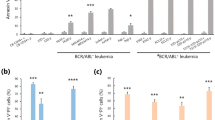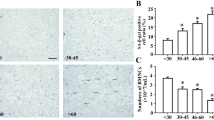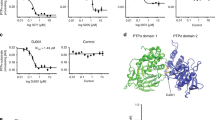Abstract
Ex vivo purging of contaminating tumor cells may reduce the incidence of relapse in patients undergoing bone marrow transplantation. In this study we demonstrate that resveratrol, a phytoalexin with anti-oxidant and chemopreventive activity, exhibits anti-leukemic activity against mouse (32Dp210, L1210) and human (U937, HL-60) leukemic cell lines by inhibiting cell proliferation. Long-term exposure to resveratrol also inhibits the clonal growth of normal hematopoietic progenitor cells but at a higher IC50 of resveratrol than that for most of the leukemia cell lines tested. The inhibitory effect of resveratrol on hematopoietic progenitors is partially reversible, whereas the effect on leukemia cells is largely irreversible. The inhibition of leukemia cells by resveratrol involves nucleosomal DNA fragmentation (apoptosis). On the other hand, resveratrol does not induce or enhance spontaneously occurring apoptotic death in normal hematopoietic progenitor cells. In vivo experiments performed with untreated and resveratrol-treated bone marrow showed comparable hematopoietic reconstitution in lethally irradiated mice (10 Gy) as determined by survival, hematologic recovery, and the number of hematopoietic progenitor cells present in the marrow of reconstituted animals. Taken together, these results indicate the potential use of resveratrol for ex vivo pharmacological purging of leukemia cells from bone marrow autografts without significant loss in the hematopoietic activity of progenitor cells. Bone Marrow Transplantation (2000) 25, 639–645.
This is a preview of subscription content, access via your institution
Access options
Subscribe to this journal
Receive 12 print issues and online access
$259.00 per year
only $21.58 per issue
Buy this article
- Purchase on Springer Link
- Instant access to full article PDF
Prices may be subject to local taxes which are calculated during checkout






Similar content being viewed by others
References
Vesole DH, Jagannath S, Glenn L, Barlogie B . Auto transplantation in multiple myeloma Hematol Oncol 1993 7: 613–630
Petersen FB, Lynch MHE, Clift RA et al. Autologous bone marrow transplantation for patients with acute myeloid leukemia in untreated first relapse or in second complete remission J Clin Oncol 1993 11: 1353–1360
Deisseroth AB, Zu Z, Claxton D et al. Genetic marking shows that ph+ cells present in autologous transplants of chronic myelogenous leukemia (CML) contribute to relapse after autologous bone marrow in CML Blood 1994 83: 3068–3076
Brenner MK, Rill DR, Moen RC et al. Gene-marking to trace origin of relapse after autologous bone marrow transplantation Lancet 1993 341: 85–86
Rill DR, Santana VM, Roberts WM et al. Direct demonstration that autologous bone marrow transplantation for solid tumors can return a multiplicity of tumorigenic cells Blood 1994 84: 380–383
Gribben JG, Arnold MD, Freedman AS et al. Immunologic purging of marrow assessed by PCR before autologous bone marrow transplantation for B-cell lymphoma New Engl J Med 1991 325: 1525–1533
Brugger W, Bross KJ, Glatt M et al. Mobilization of tumor cells and hematopoietic progenitor cells into peripheral blood of patients with solid tumors Blood 1994 83: 636–640
Yeager AM, Kaizer H, Santos GW et al. Autologous bone marrow transplantation in patients with acute nonlymphocytic leukemia using ex vivo marrow treatment with 4-hydroxycyclophosphamide New Engl J Med 1986 315: 141–147
Jones RJ . Purging with 4-hydroperoxycyclophosphamide J Hematother 1992 1: 343–348
Laporte JP, Douay L, Lopez M et al. One hundred twenty-five adult patients with primary acute leukemia autografted with marrow purged with mafosamide: A 10 year single institution experience Blood 1994 84: 3810–3818
Gulati SC, Acaba L, Yahalom J et al. Autologous bone marrow transplantation for acute myelogenous leukemia using 4 hydroperoxycyclophosphamide and VP-16 purged bone marrow Bone Marrow Transplant 1992 10: 129–137
Gorin NC, Aegerter P, Auvert B et al. Autologous bone marrow transplantation for acute myelocytic leukemia in first remission: a European survey of the role of marrow purging Blood 1990 75: 1606–1614
Belguendouz L, Fremont L, Gozzelino MT . Interaction of transresveratrol with plasma lipoproteins Biochem Pharmacol 1998 15: 811–816
Frankel EN, Waterhouse AL, Kinsella JE . Inhibition of human LDL oxidation by resveratrol Lancet 1993 341: 1103–1104
Pace-Asciak CR, Hahn S, Diamandis EP et al. The red wine phenolics trans-resveratrol and quercetin block human platelet aggregation and eicosanoid synthesis: implications for protection against coronary heart disease Clin Chim Acta 1995 235: 207–219
Rotondo S, Rajtar G, Manarini S et al. Effects of trans-resveratrol, a natural polyphenolic compound, on human polymorphonuclear leukocyte function Br J Pharmacol 1998 123: 1691–1699
Kimura Y, Okuda H, Arichi S . Effects of stilbenes on arachidonate metabolism in leukocytes Biochim Biophys Acta 1985 834: 275–278
Belguendouz L, Fremont L, Linard A . Resveratrol inhibits metal ion-dependent and independent peroxidation of porcine low-density lipoproteins Biochem Pharmacol 1997 53: 1347–1355
Bertelli AA, Giovannini L, Bernini W et al. Antiplatelet activity of cis-resveratrol Drugs Exp Clin Res 1996 22: 61–63
Jang M, Cai L, Udeani GO et al. Cancer chemopreventive activity of resveratrol, a natural product derived from grapes Science 1997 275: 218–220
Mgbonyebi OP, Russo J, Russo IH . Antiproliferative effect of synthetic resveratrol on human breast epithelial cells Int J Oncol 1998 12: 865–869
Jayatilake GS, Jayasuria H, Lee HS et al. Kinase inhibitors from poly gonum cuspidatum J Nat Prod 1993 56: 1805–1810
Synold TW, Doroshow TW . Resveratrol, a phenolic constituent of wine inhibits topoisomerase II and induces apoptosis in human leukemia cells Proc Am Assoc Cancer Res 1998 39: 422 (Abstr.)
Clement MV, Hirapa JL, Chawdhury SH, Pervaiz S . Chemopreventive agent resveratrol, a natural product derived from grapes, triggers CD95 signaling-dependent apoptosis in human tumor cells Blood 1998 92: 996–1002
Acknowledgements
We are grateful to Drs Alfonso Scicli and Howard Haspel for critical review of this paper and Cindy Bonwell for her expert secretarial support. This work was supported by the Van Patrick Cancer Research Fund and a grant from the Elsa U Pardee Foundation.
Author information
Authors and Affiliations
Rights and permissions
About this article
Cite this article
Gautam, S., Xu, Y., Dumaguin, M. et al. Resveratrol selectively inhibits leukemia cells: a prospective agent for ex vivo bone marrow purging. Bone Marrow Transplant 25, 639–645 (2000). https://doi.org/10.1038/sj.bmt.1702189
Received:
Accepted:
Published:
Issue Date:
DOI: https://doi.org/10.1038/sj.bmt.1702189
Keywords
This article is cited by
-
Pterostilbene induces apoptosis and cell cycle arrest in diffuse large B-cell lymphoma cells
Scientific Reports (2016)
-
Resveratrol induces human K562 cell apoptosis, erythroid differentiation, and autophagy
Tumor Biology (2014)
-
Resveratrol Mobilizes Endogenous Copper in Human Peripheral Lymphocytes Leading to Oxidative DNA Breakage: A Putative Mechanism for Chemoprevention of Cancer
Pharmaceutical Research (2010)
-
Computer design of trans-stilbene derivatives with pronounced anti-inflammatory activity and low toxicity
Pharmaceutical Chemistry Journal (2009)
-
Mitochondrial concept of leukemogenesis: key role of oxygen-peroxide effects
Theoretical Biology and Medical Modelling (2008)



